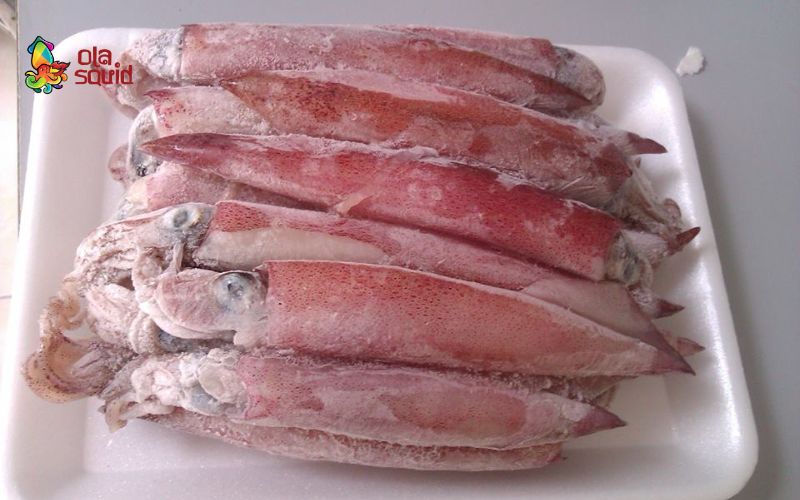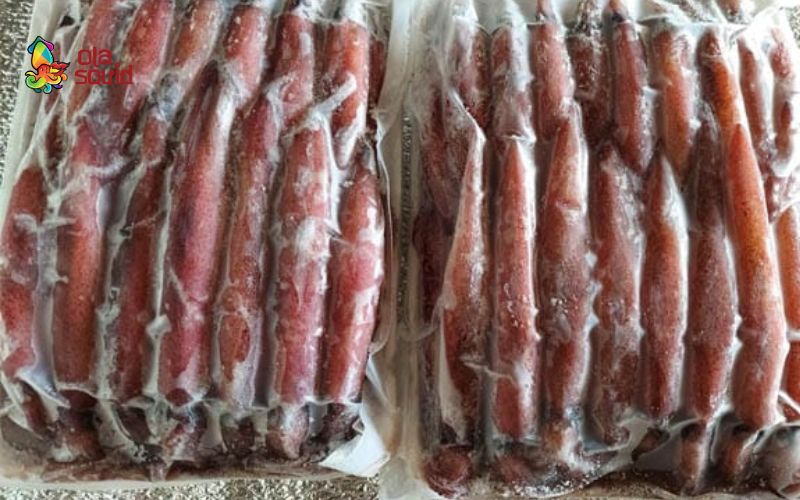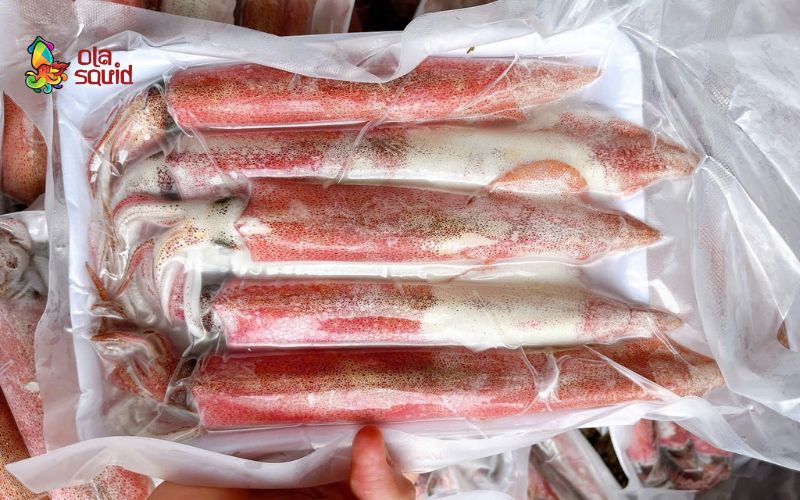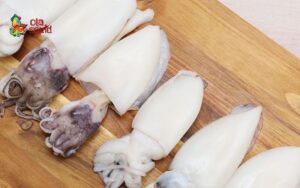Frozen Squid is an increasingly popular choice in modern kitchens due to its convenience in storage, preparation, and its ability to retain fresh flavor and nutritional value comparable to fresh squid. So, what are the characteristics of frozen squid? How to choose, store, and prepare delicious dishes with frozen squid? Let’s find out in the article below to answer these questions!
What is Frozen Squid?
Frozen squid is squid caught from the sea, then preliminarily cleaned and rapidly frozen at low temperatures for long-term preservation. The freezing process helps retain the freshness, characteristic flavor, and nutritional value of the squid.

Unlike fresh squid that needs to be consumed immediately after being caught, frozen squid can be stored for a long time, is easy to transport, and can be used flexibly in many different dishes. Thanks to modern freezing technology, the squid still retains its natural white-pink color, characteristic chewy texture, and delicious flavor when cooked.
How to Choose Fresh and Delicious Frozen Squid
To prepare delicious and flavorful dishes from frozen squid, you should pay attention to the following signs:
- Observe the color: Frozen squid of good quality usually has a natural white-pink color or a slight light purple hue on the skin. The squid body is bright, not dull or discolored. Avoid choosing squid with pale, yellowish colors, as this may indicate that the squid has been stored for a long time or poorly preserved.
- Check elasticity: When touching the squid’s body, you will feel its firmness and elasticity. Good squid is not mushy or watery, and certainly not covered in thick ice.
- Squid smell: Fresh frozen squid will have a characteristic mild fishy smell, not a strange, sour, or ammoniac odor. If the squid has an unusual smell, you should avoid buying it to ensure your health.
- Clear packaging and labels: Prioritize squid that is tightly packaged, with intact packaging, no tears, and no signs of condensation inside. The information on the packaging must be complete, including the production date, expiry date, place of origin, and food safety certification.
- Buy from reputable sources: It is advisable to buy frozen fresh squid from large supermarkets, reputable seafood stores, or quality-assured brands.
How to Store Frozen Squid
To ensure frozen squid always retains its freshness, sweetness, and food safety when used, you need to understand some storage principles:
- Store at the appropriate temperature: Place the squid in the freezer at -18°C or lower immediately after purchase. Do not leave the squid at room temperature for too long, as this will reduce its quality and make it prone to bacterial contamination.
- Avoid thawing and refreezing: Do not thaw and refreeze. This process will damage the squid’s flesh structure, making it mushy, losing its sweetness, and posing a risk of bacterial growth.
- Seal tightly before freezing: If you buy a large quantity of squid, divide it into small portions for each meal. Use zip-lock bags, vacuum-sealed bags, or tightly sealed plastic containers for storage to prevent the squid from coming into contact with air and cold.

- Keep the freezer clean: Ensure the freezer is clean, free from strange odors, and not stored with other fresh foods. You should place the squid in a fixed position and avoid moving it to prevent affecting the ice layer surrounding the squid.
- Label and track usage time: Clearly write the freezing date on the packaging or container for easy management. Although squid can be stored for 2-3 months, it is best to use it within 1 month to preserve nutrients.
- Thaw properly before use: Thaw the squid by moving it to the refrigerator’s cool compartment for 6-8 hours or soaking the squid (sealed) in cold water for 15-20 minutes. Avoid thawing with hot water or leaving it at room temperature for too long.
Benefits of Using Frozen Squid
Using frozen fresh squid offers convenience in modern life and is a nutritious choice for health. Here are the outstanding benefits:
- Good for health: Squid is a rich source of essential nutrients such as selenium and vitamin B, which help with antioxidant effects, support the prevention of arthritis, reduce migraines, and enhance nerve function. Furthermore, squid provides copper and calcium, aiding in red blood cell production and strengthening bones and teeth, preventing osteoporosis.
- Retains freshness and quality: Thanks to modern freezing processes, squid is preserved immediately after being caught, retaining its natural freshness, sweetness, and nutritional content with almost no loss.
- Safe, convenient, and time-saving: Packaged and meticulously inspected, ensuring food safety. Without needing to go to the market every day, you always have ingredients in the refrigerator to prepare meals quickly.
- Versatile cooking methods: Frozen squid can be prepared into many delicious dishes such as steaming, grilling, stir-frying, deep-frying, etc., while maintaining its deliciousness and not becoming dry or mushy.

How to Prepare Frozen Squid
Before cooking, you need to prepare the squid properly to ensure the dish is delicious and not fishy:
- Step 1 – Thawing: First, place the frozen squid in the refrigerator’s cool compartment for about 6-8 hours or soak it in cold water for 15-20 minutes to thaw slowly.
- Step 2 – Washing: After thawing, wash the squid thoroughly with diluted saltwater or vinegar water to remove the fishy smell and any dirt, then rinse several times.
- Step 3 – Peeling and removing innards: Gently pull the head to remove the innards, discard the ink sac, and remove the backbone. Carefully use a small knife to peel off the purple skin if you want a visually appealing white dish.
- Step 4 – Cutting the squid: Depending on the dish you are preparing, you can leave the squid whole, cut it into rings, or slice it into strips.
Delicious Dishes with Frozen Squid
Frozen squid can be used to prepare many delicious and attractive dishes. Here are some simple yet flavorful squid dish suggestions you can try:
Spicy Satay Grilled Squid
With its spicy and aromatic flavor, spicy satay grilled squid is a favorite dish for many. After marinating with satay sauce, minced garlic, oyster sauce, sugar, fish sauce, and a little honey, the squid is grilled over charcoal or in an oven until slightly charred. This dish is perfect for barbecue parties or weekend snacks.

Sweet and Sour Stir-fried Squid
Sweet and sour stir-fried squid has a refreshing sourness from vinegar and a gentle sweetness from sugar, combined with the savory taste of fish sauce, making it appetizing and easy to eat. Simply stir-fry the squid with onions, bell peppers, tomatoes, and sweet and sour sauce to create a dish that is both visually appealing and delicious.
Steamed Squid with Ginger
If you prefer a light, low-oil option, steamed squid with ginger is a must-try. Steaming preserves the squid’s natural freshness, sweetness, and chewy texture. Simply marinate the squid with ginger slices, scallions, a little pepper, and steam for about 10-15 minutes to create a delicious and nutritious dish.
With its delicious flavor, high nutritional value, and convenience in storage, frozen squid is becoming a favorite choice for many home cooks. We hope this article has helped you better understand the characteristics, selection, and preparation of frozen squid. And if you have any other questions about squid products, especially dried squid, don’t hesitate to contact Ola Squid right away!


 Tiếng Việt
Tiếng Việt ไทย
ไทย




